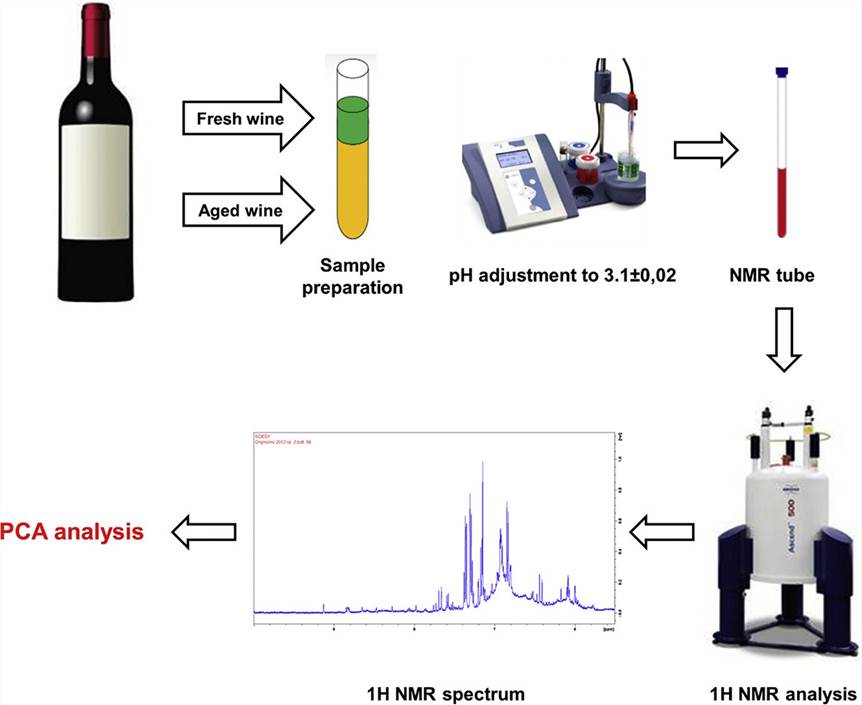NMR-based Alcoholic Beverage Analysis
Wine is an important commodity with high added value. Not only from the historical point of view, but also from the economic point of view, especially for wine-producing countries, a large number of studies have been put into the application of NMR in wine analysis. The main advantage of NMR spectroscopy is that it provides a simple and fast method to obtain the chemical components of grapes, grape juice, grape juice and wine, and identify a variety of secondary organic compounds (metabolite analysis), including amino acids, organic acids and alcohols, sugars and phenolic compounds.
As an expert in the field of nuclear magnetic resonance, Creative Biostructure provides varieties, years and origins of wine based on NMR. Analysis service of wine quality and authenticity to enhance your brand image and ensure the quality and authenticity of your products.
 Figure 1. NMR-based wine analysis (Cassino et al., 2019)
Figure 1. NMR-based wine analysis (Cassino et al., 2019)
Our Service
- Analysis of wine metabolites
| Spectral technique | Application |
|---|---|
| 1H NMR spectrum | It can be used for the determination of ethanol content. |
| 13C NMR spectrum | It can be used for the identification and quantification of organic compounds in wine. |
| Homonuclear and heteronuclear 2D NMR spectroscopy | It can be used for distribution verification of trace organic compounds. |
| CP-MAS NMR spectrum | Sediment analysis of wine. |
Determination of trace components in wine. We usually use freeze drying or inert gas flow (nitrogen, argon) to preconcentrate the sample to physically remove water/ethanol, so as to enhance the detection of weak proton NMR signals of trace compounds in wine and promote their identification.
The main components of wine can be determined by NMR spectrum, including organic acids and glycols (tartaric acid, succinic acid, acetic acid, glycerol, 2,3-butanediol, lactic acid), amino acids (proline, alanine, arginine), carbohydrates (glucose), fructose) and polyphenols (gallic acid, 2-phenylethanol, tyrosol).
- Phenols
The polyphenols that can be determined by NMR spectrum include phenolic acid, flavanol, stilbene compound, dihydroflavonol, flavanol monomer (catechin), flavanol polymer (proanthocyanidin) and anthocyanin.
- Other analysis services
| Aim of NMR Study | NMR Technique |
|---|---|
| Grape berries | 1H, J-res, COSY, HMBC, HSQC |
| Grape pulp | HR-MAS, COSY, TOCSY, J-res, HSQC, HMBC |
| Variety | 1H, COSY, 13C, J-res, HSQC |
| Harvesting time | 1H, J-res, COSY, HMBC, HSQC |
| Terroir | HR-MAS, COSY, TOCSY, J-res, HSQC, HMBC |
| Cultivation practices | 1H |
| Cultivation technique | 1H, 13C, COSY, HSQC, HMBC |
| Geographical origin | 1H, 13C, HMBC, HSQC |
| Vintage | HR-MAS, COSY, TOCSY, J-res, HSQC, HMBC |
| Yeast strain applied in fermentation | 1H, COSY, TOCSY, HSQC, HMBC |
| Infection by plant pathogen | 1H, J-res, TOCSY, COSY, HMBC, HSQC |
| Sensoric profile | 1H, COSY, HSQC |
| Ageing | 1H, COSY, TOCSY, HSQC, DOSY |
| Wine blending | 1H |
| Assessment of wine antioxidative potential and influence on aging conditions | 1H, 13C, COSY, HSQC, HMBC |
| Identification and characterization of minor wine components with sensoric or bioactive role | 1H, 13C, COSY, NOESY, TOCSY, ROESY, HMBC, HSQC, HMQC |
| Interactions between wine components with sensoric role | 1H, 13C, HMQC, HMBC, COSY, CP-MAS NMR |
Wine Authenticity Test
The consequences of wine counterfeiting are devastating for wine growers, because they weaken consumers' confidence in dissolved oxygen, regions or grape varieties, leading to a sharp decline in sales. Creative Biostructure solution is an innovative and powerful method to detect and prevent wine fraud.
| Parameters that are qualified in wine | |
|---|---|
| Standard parameters | Arabinose, bread units, carbohydrate units, citric acid, energy value, ethanol, fructose, glucose, glucose /fructose, glycerol, lactic acid, malic acid, must weight, sucrose, sugar-free extract, tartaric acid, total alcohol, total extract |
| Degradation parameters | Acetic acid, acetone, cadaverine, ethyl acetate, formic acid, fumaric acid, furfural, gluconic acid, HMF |
| Amino acids | 4-aminobutanoic acid, alanine, arginine, proline |
| (Poly-) phenols | Caftaric acid, epicatechin, gallic acid, shikimic acid, trigonelline |
| Stabilizing agents | Benzoic acid, salicylic acid, sorbic acid, shikimic acid |
| Higher alcohols/fermentation products | 1,3-propanediol, 2,3-butanediol, 2-methyl-propanol, 2-phenylethanol, 3-methyl-butanol, acetaldehyde, galacturonic acid, glycerol/ethanol, methanol, pyruvic acid |
Creative Biostructure is committed to providing high-quality NMR analysis services to advance the life sciences fields. If you have any questions or needs, please contact us and our customer service staff will help you the first time.
Ordering Process
Reference
- Cassino C, et al. Wine evolution during bottle aging, studied by 1H NMR spectroscopy and multivariate statistical analysis. Food Research International. 2019, 116: 566-577.

